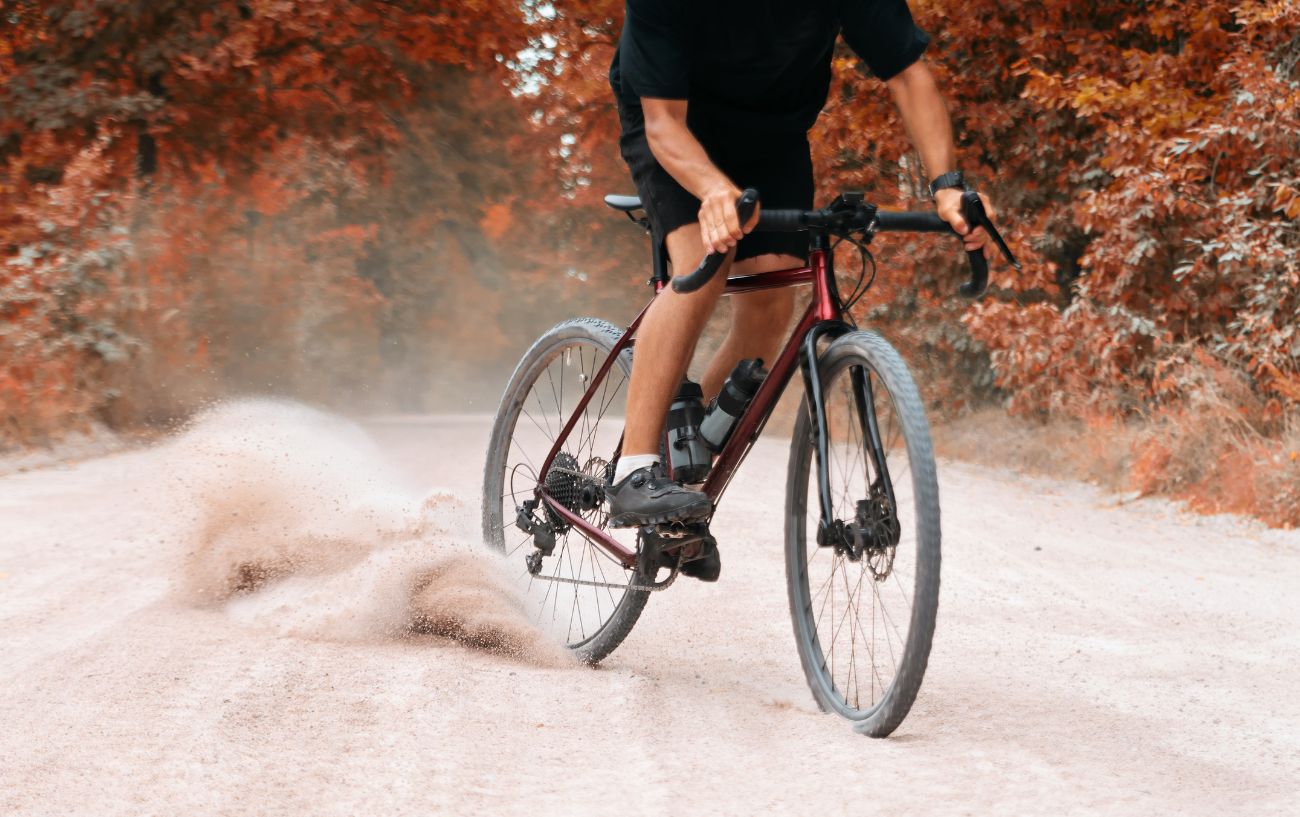Gravel bikes have been the hot new thing in the cycling world in the last few years.
If you’ve felt the call of gravel beckoning you into unpaved territory, you might begin your search for a gravel bike only to be met with wallet-gouging prices.
Unfortunately, we all know that buying a quality bike is no cheap ordeal. The good news is that you can convert road bike to gravel bike with just a bit of work!
In this article, we’ll be covering:
- What Is A Gravel Bike?
- Can You Put Gravel Tires On A Road Bike?
- How To Convert Road Bike To Gravel Bike In 4 Steps
Ready to grind some gravel?
Let’s get wrenching!

What Is A Gravel Bike?
Gravel bikes don’t have a plethora of clear defining factors. This is both a good and a bad thing for the gravel-curious community.
It’s good because depending on your tolerance for discomfort, pretty much any road bike you can put gravel tires on can be a gravel bike.
It can also be a negative because for those looking to convert a bike, or understand the differences, it can be hard to get clear-cut answers on what makes a purpose-built gravel bike special.
This is mostly attributable to the nuances of gravel bikes.
As the sport grows, the standard for what makes a top-spec gravel bike seems to change yearly. However, there are a couple of features that make the gravel bike markedly different from the road bike.

Gravel bikes have a longer wheelbase, and slacker head angle.
These differences increase stability by making the bike less prone to pitching forward in uneven terrain, as well as reducing twitchiness – at the expense of decreased steering responsiveness.
The most important difference is likely the tires and wheels.
While modern road bikes run an industry-standard 700c wheelset with typical tire widths from 23-28 mm, gravel bikes often run either 700c or 650b wheelsets with tire widths up to 45mm.
Wider tires allow riders to run lower tire pressures and increase surface area which increases traction over uneven terrain. A more aggressive tread pattern increases traction similarly.
Other features of a gravel bike include things like considerations for comfort at contact points and minor component changes like pedals and shoes.
Gravel bikes tend to have wider (and sometimes flared) handlebars for increased control and comfort over technical terrain.
Many riders will also choose to run a 2-bolt SPD pedal and shoe, like mountain bikers, for increased comfort walking in unpaved areas.

Can You Put Gravel Tires On A Road Bike?
The answer is a resounding: “It depends”.
As we’ve learned, there are some key differences between road bikes and gravel bikes. The biggest issue you’re likely to run into when converting your road bike to a gravel bike is fitting tires.
Some gravel bikes run tires as wide as 45mm, with a popular standard tire width of around 40mm emerging. Considering that the average road bike tire on a 700c wheel is less than 30mm, this is a big jump.
With this knowledge, your best bet is to try it out with tires of greater width and see what your bike can accommodate, as there is no “one size fits all” answer.
Some frames simply won’t have enough clearance to run wider tires. They might rub against the fork, for example, or the chainstays might be too short causing the rear tire to contact the seat tube.
You’re likely to be able to fit a tire just wide enough for light gravel on most enduro-style road bikes. You’ll usually be able to find a maximum tire width listed in your frame’s manufacturer specifications.
These are often a little on the conservative side though – so the only way to know for sure is to head to your local bike shop and try it for yourself!

How To Convert Road Bike To Gravel Bike In 3 Steps
#1. Swap Your Tires (And Possibly Your Wheels!)
Gravel riding requires larger-width tires, with more aggressive tread, capable of running lower pressures to increase traction and stability.
If you do nothing else in your conversion, get some wider tires.
Road bikes run tires that are too skinny to weather gravel of any kind. You’ll need to upgrade your tires to those with a minimum width of 32 mm.
It’s also worth switching to wheels with a wider rim width to really reap the rewards of wider tires.
Typically, a wider tire equates to a higher-volume tire.
Higher-volume tires can be run at a lower PSI. The lower PSI will allow you to increase your traction as you roll over the uneven terrain features present in gravel cycling.
Remember how we said putting grave tires on a road bike just depends?

It’s important that you pay special attention to your tire clearance when moving to wider tires on a road bike. Many road bikes are only equipped to handle a maximum tire size of 28-30 mm while still allowing the recommended 3 mm of clearance.
If you find that 32 mm tires are not beefy enough for you, but your frame won’t tolerate a bigger tire, a workaround you can employ is to swap your wheelset.
Road bikes run an industry-standard 700c wheelset, so by swapping to a smaller 650b wheelset, you can usually create space to fit larger tires without clearance issues.
You may run into a couple of problems here.
Your road bike’s geometry was designed for a 700c wheel. When you switch to a 650b wheel, you’ll drop the bottom bracket height. This will negatively impact your clearance.
The second is that bikes running caliper brakes may not be able to accommodate a 650b wheel. 650b wheelsets have a larger rim width than the standard 700C, and the rim sits lower. Your rim brake caliper may not be compliant with a smaller wheel.
This can be mitigated by switching to a long-reach brake caliper.
These problems are not the death of your road-to-gravel conversion, but they are things you should consider as potential obstacles.

#2. Get The Gearing Right
One option you might want to look into fitting your converted gravel bike with a 1x drivetrain.
It’s easy enough to pick up a gravel-focused chainring for your bike. Standard gravel chainrings are around 42t, as they provide a comfortable mix of climbing capability and descent readiness.
Where you might start running into issues is that you might find your cassette doesn’t provide a wide enough range of gears to ride comfortably when set up as a 1x. This is because your standard road bike cassette is likely designed with a 2x drivetrain in mind.
Swapping to a bigger cassette that provides a wider range of gears can solve this – though be careful to check for compatibility issues.
- Check out our Complete Guide to Gear Ratios here!

#3. Components
Start with the handlebars. A wider bar on your bike gives you more control over the handling of the bike.
There’s no correct width for bars here.
What you’re looking for in a gravel handlebar is wider than you’d have on a road bike, but still depends on your shoulder width and personal preference. Start with what you have on your bike currently, and size up gradually to see what’s comfortable.
Too wide is just as hard to control as too narrow!
You may opt for a gravel-specific bar, the flared drop bar. This is is a drop bar with drops that flare outward from the hoods for extra control. Consider starting with a moderate flare, 12-16 degrees, and see what you like!
You can also consider a shorter stem and adding a couple of spacers. By shortening and heightening the stem, you’ll bring your weight back and over the center of the bike.
This makes your bike more stable on pitched terrain, and can also provide a more comfortable (but less aerodynamic) riding position.
Finally, you’ll want to consider your other contact points: the saddle and pedals.
Many a gravel cyclist will choose to run SPD pedals with a compatible 2-bolt cleat and shoe.
This isn’t entirely necessary, but should you end up having to hike sections, having a pedal and cleat system that’s better suited to walking than the road-standard SPD-SL will be beneficial.
You can upgrade your saddle to one that’s slightly more padded for comfort – or go all out and get a suspension seatpost!

Now you’re ready to get Converting!
With what you’ve read here, you can get out to the garage and start to convert road bike to gravel bike yourself!
The process to convert road bike to gravel bike is relatively simple. Though, as we discussed, you’ll need to watch out for a couple of small issues when swapping wheels and tires.
Just follow the above steps, which we’ve put in order of significance to get your bike gravel ready.
You’ll be grinding gravel in no time!




As an ol’ steel is real roadie, I’m purchasing a new Giant Defy. When it comes in, I plan to convert my steel Gunnar Roadie into a gravel grinder. Good article. I’m going to my buddies garage to try to bend/flair my handlebars